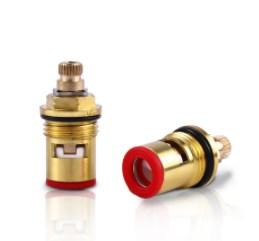In the realm of fluid control systems, the integrity of the sealing mechanism is paramount to ensure the efficient and safe operation of various industrial processes. One component that has been gaining significant attention for its exceptional sealing capabilities is the Ceramic Valve Core. This article delves into the intricacies of the sealing performance of ceramic valve cores, highlighting their advantages and the reasons behind their growing popularity in the field of fluid control.
Ceramic valve cores are engineered to provide a high level of resistance against wear and tear, a characteristic that is crucial for maintaining a tight seal in valve systems. The material's inherent hardness and chemical inertness make it an ideal choice for applications where traditional metal valve cores may falter. The ceramic's resistance to corrosion and its ability to withstand high temperatures without degrading are key factors that contribute to its superior sealing performance.
One of the most notable aspects of ceramic valve cores is their ability to maintain a consistent seal over time. Unlike metal valve cores, which can experience wear due to the constant opening and closing of the valve, ceramic valve cores exhibit minimal wear, ensuring a reliable seal throughout their service life. This durability is particularly beneficial in applications where the valve is subjected to frequent operation, as it reduces the need for maintenance and replacement, ultimately leading to cost savings.
The sealing performance of ceramic valve cores is further enhanced by their smooth surface finish. The precision engineering of these components allows for a tight seal with minimal leakage, which is essential in industries where the containment of fluids is critical. This is especially true in the chemical and pharmaceutical sectors, where the leakage of hazardous substances can have severe environmental and health implications.
Moreover, the use of ceramic valve cores can lead to improved system efficiency. The reduced friction between the valve core and the seat, due to the low coefficient of friction of ceramic, results in a smoother operation. This not only minimizes energy loss but also reduces the risk of valve failure, which can be catastrophic in certain applications.
Another factor that contributes to the superior sealing performance of ceramic valve cores is their resistance to chemical attack. In environments where aggressive chemicals are present, ceramic valve cores can provide a reliable barrier, preventing the valve from being compromised by corrosive substances. This is a significant advantage over metal valve cores, which can be susceptible to corrosion, leading to seal failure and potential leaks.
The compatibility of ceramic valve cores with a wide range of sealing materials is another aspect that enhances their sealing performance. Whether it is a soft seat made from rubber or a hard seat made from metal, ceramic valve cores can form a strong seal, ensuring that the valve functions effectively under various conditions.
In conclusion, the sealing performance of ceramic valve cores is a testament to the advancements in materials science and engineering. Their ability to provide a durable, efficient, and reliable seal in a wide range of applications has made them a preferred choice for many industries. As technology continues to evolve, the use of ceramic valve cores will likely become even more prevalent, further solidifying their position as a key component in fluid control systems. The future of valve technology looks promising with ceramic valve cores at the forefront, offering a solution that combines durability, efficiency, and safety in a single, high-performing package.
